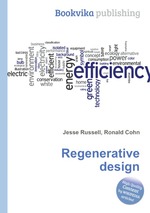Regenerative design
Jesse Russell Ronald Cohn
бумажная книга
High Quality Content by WIKIPEDIA articles! Regenerative design (sometimes referred to as cradle-to-cradle design) is a process-oriented systems theory based approach to design. The term "regenerative" describes processes that restore, renew or revitalize their own sources of energy and materials, creating sustainable systems that integrate the needs of society with the integrity of nature. The basis is derived from systems ecology with a closed loop input–output model or a model in which the output is greater than or equal to the input with all outputs viable and all inputs accounted for. Regenerative design is the biomimicry of ecosystems that provide for all human systems to function as a closed viable ecological economics system for all industry. It parallels ecosystems in that organic (biotic) and synthetic (abiotic) material is not just metabolized but metamorphosed into new viable materials. Ecosystems and Regeneratively designed systems are holistic frameworks that seeks to create systems that are absolutely waste free. The model is meant to be applied to many different aspects of human habitation such as urban environments, buildings, economics, industry and social systems. Simply put, it is the design of ecosystems and human behavior, or culture that function as human habitats.


